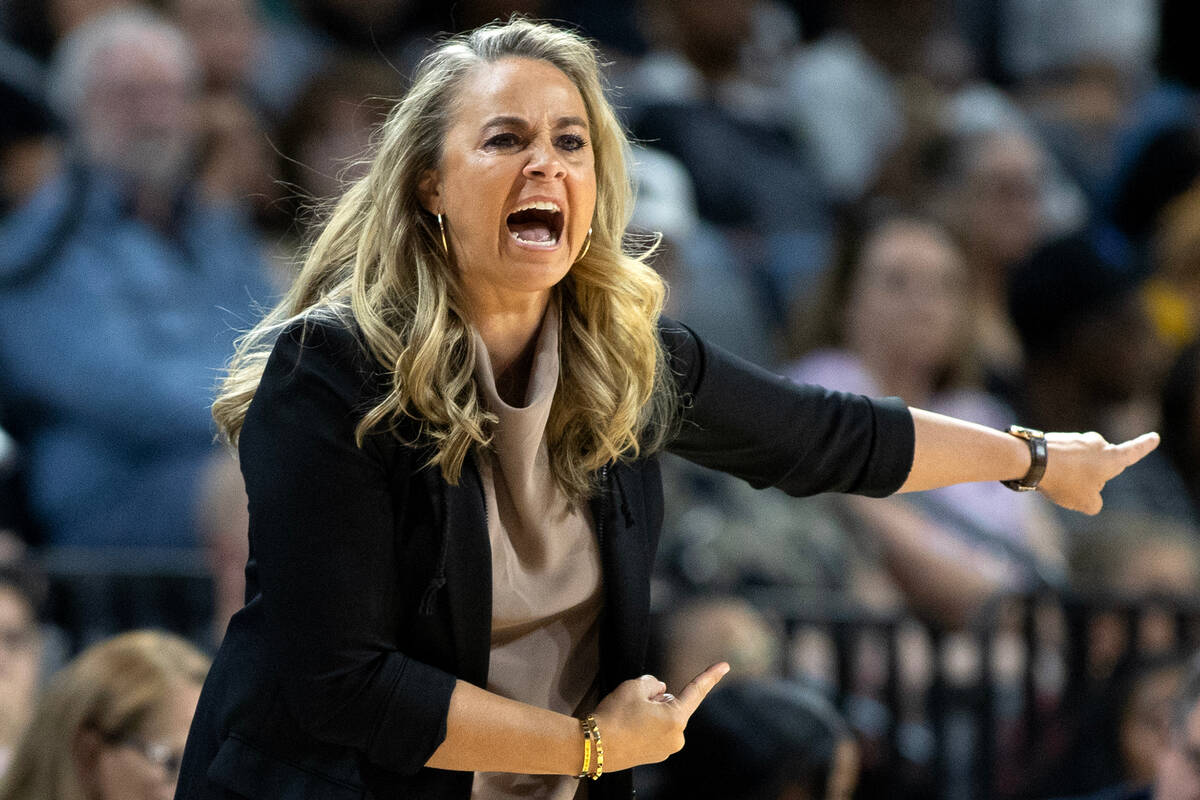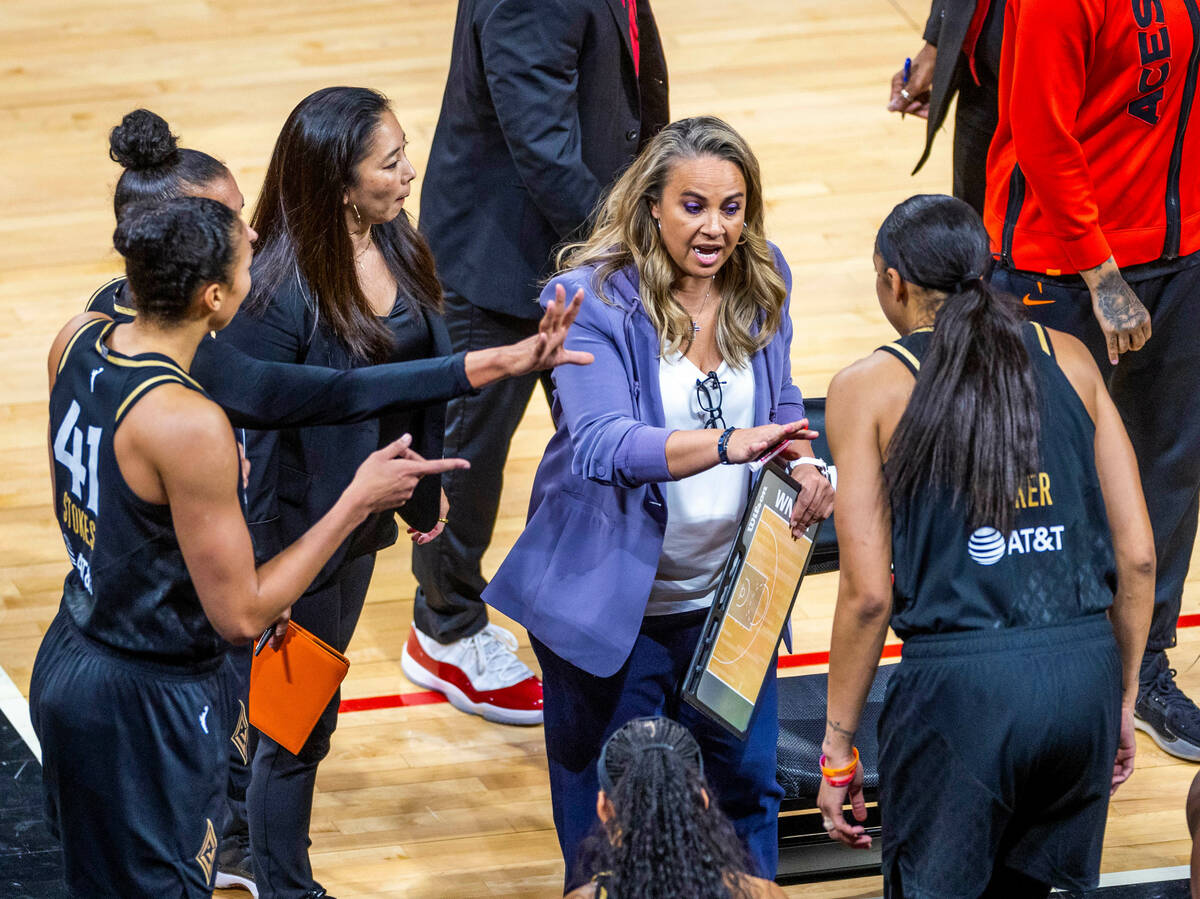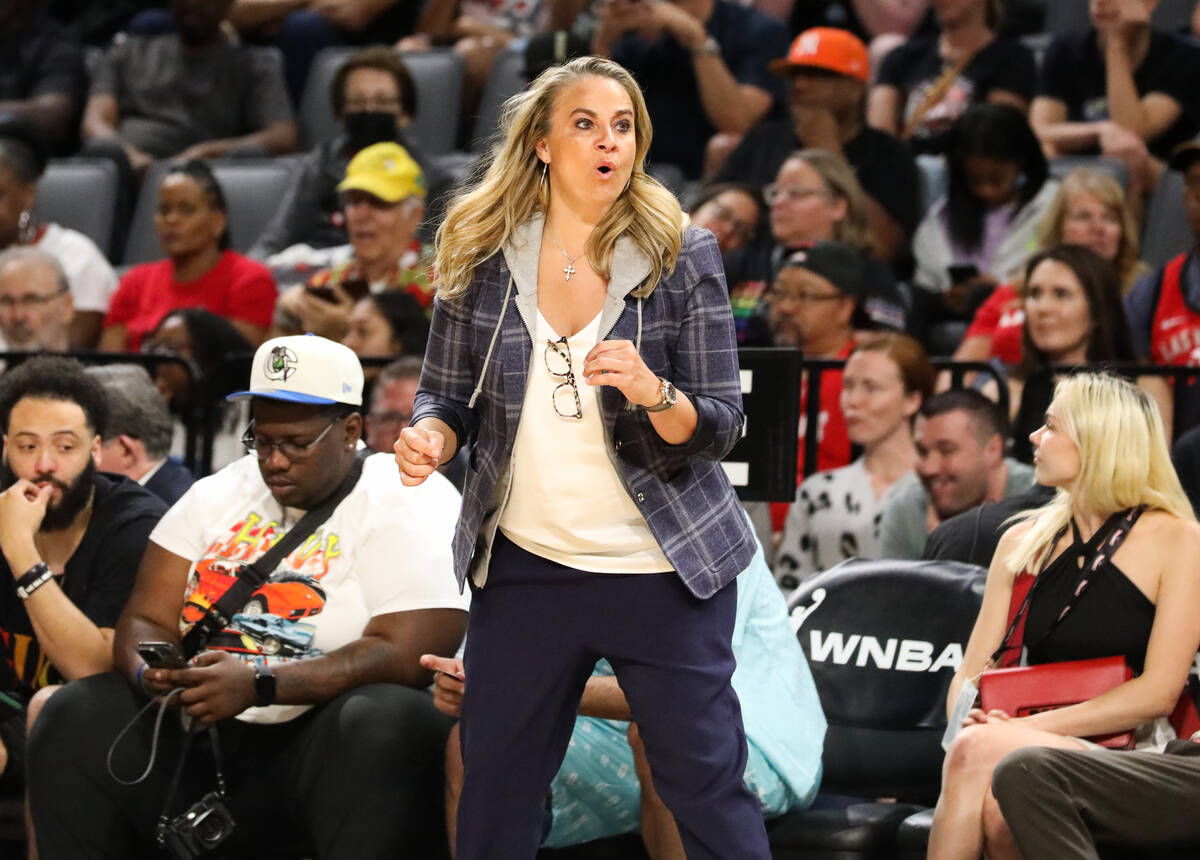Beckyball 101: How Becky Hammon’s ‘basic’ offense turned the Aces into a juggernaut
Speaking at UNLV’s Cox Pavilion practice gym on April 18, 2022, Becky Hammon — fresh off her second practice as coach of the Aces — laid out her offensive philosophy publicly for the first time.
Hammon described a system that contained structure but granted her players the freedom to showcase their unique talents, feel empowered to make decisions on the fly and utilize basketball principles instead of relying on specific play calls.
She wanted the Aces to play the right way, make the extra pass and give up good shots for great ones.
“It’s pretty simple,” she said. “It’s pretty basic.”
Her results speak for themselves. The Aces won their first championship in franchise history in 2022. Hammon was named WNBA coach of the year, and the Aces led the league in offensive rating (109.6) and points per game (90.4).
They’ve only improved this season. Entering Sunday, the Aces are on pace to set league records for offensive rating, average scoring differential and points per game. Hammon, whose career coaching record stands at 48-12, holds the highest winning percentage (.800) among any WNBA coach with more than 15 games of experience.
So what makes Beckyball so special?
“I don’t see them running a lot of plays,” College of Southern Nevada coach Mike Lee said. “They have different sets that they can work off of, but it doesn’t look like a lot of plays.”
Added UNLV women’s basketball coach Lindy La Rocque: “They may say they don’t have a ton of set plays, but they have actions they know they like to get mismatches, to get people where they want them. They do have some structure to it.”
Hammon said there are three key tenets to her system: Pace, space and sharing. To make it work, she requires players who can communicate, trust the system and each other and have the basketball intelligence to make the correct decisions based on opposing defense’s reactions.
“A lot of times as a head coach, you want to control everything,” Hammon said. “But there are some things that you can’t control, and you shouldn’t control.
“It’s better in the control of the people who are actually doing it.”
Pace
It’s no secret Hammon wants her team to punish opponents in transition. The Aces rank second in points off opposing turnovers per game (17.6) behind the Connecticut Sun this season and are tied for second in fast-break points per game (13.0) behind only the Dallas Wings.
All-Star point guard Chelsea Gray said learning to play at the Aces’ fast pace was the biggest adjustment she had to make when Hammon introduced her system in 2022. Reigning WNBA MVP A’ja Wilson agreed.
“We play really, really fast,” Wilson said. “Our pace is crazy, especially coming into training camp because we’re all hyper and ready to go. So the pace of the game is very hard to grasp because you want to be fast, you want to move with pace. But at the same time, you have to be in the right place at the right time and do all that.”
Hammon said the fast-break principles that all basketball players are taught apply to her entire offense. She said there are no plays in transition. Instead, the offense uses a variety of screens or spacing to open lanes to the basket.
This same flow is applied to the Aces’ half-court offense. It works as long as the team maintains its offensive principles.
“It depends what the defense is doing,” Hammon said. “But at the end of the day, we need people filling the corners, and we need space for people to operate.”
Space
Hammon acknowledges that she likes players who can shoot from distance. The Aces averaged just 13.5 3s per game during the 2021 season, the lowest in the league. It was the fourth consecutive year the team ranked last in the WNBA in attempted 3s per game.
During Hammon’s first season with the Aces, they averaged 26.4 attempted 3s per game, ranking third in the WNBA.
However, Hammon doesn’t want people to misconstrue her appreciation of 3s as an obsession. The Aces also score 41.1 points in the paint per game this season, trailing only the Wings (41.4).
Just eight teams in WNBA history — including the 2020 and 2021 Aces coached by Bill Laimbeer — have averaged more than 40 points in the paint during an entire season.
“I don’t want my teams to ever fall in love with only 3s,” Hammon said.
Dallas does its damage in the paint by employing centers Teaira McCowan and Kalani Brown, both listed at 6 feet, 7 inches. The Aces, in contrast, use their elite spacing to create easy paths to the rim. All-Stars Jackie Young, Kelsey Plum and Gray are all among the league’s best 3-point shooters, freeing up space for Wilson in the low post.
The Aces have other methods to create space, too. They like to play out of an empty-side pick and roll, where two players are involved in a traditional pick and roll, but the other three are spacing the floor on the opposite side of the court to occupy opposing defenders, leaving lots of room for the play initiator to navigate the screen.
Other times, the Aces utilize something La Rocque called the touch series. The quick action, which has a guard dribble toward a forward, give the ball up, then immediately get the ball back, was La Rocque’s example of a concept Hammon adapted from the NBA, where it was popularized by Stephen Curry and the Golden State Warriors.
Hammon said she likes the touch series and dribble handoffs because they have similar results to a pick and roll but are quicker to set up. She also cited the motion-based Princeton offense created by Pete Carril as an influence for her inclusion of these principles.
Additionally, the Aces use off-ball screens to create space. Guards, in particular, are asked to set picks for each other, and Hammon will add wrinkles like having guards screen for forwards when the opposing team has less mobile post players.
“It’s like a give-and-take factor, trying to be selfless and get your teammate open,” Gray said.
The Aces can take advantage of space because of their intelligent cutters. Many of their plays come out of similar-looking sets, so a well-timed cut can create a wide-open opportunity at the rim when the defense thinks it knows what the Aces have planned.
Players are required to read the opposing defense to determine which route to take. If an opponent is aggressively denying the ball, slip them for a backdoor cut. If they’re lagging behind, run them through a couple screens. If the defense is hedging or blitzing the pick and roll, do a short roll toward the basket.
Lee noted that coordinating these movements requires lots of chemistry. Wilson said she’s in constant communication with her fellow forwards about who’s cutting and when. If her teammate cuts, she stays on the perimeter and vice versa.
“It just comes from a lot of reps with one another,” Wilson said.
Sharing
The final tenet of Hammon’s offense, sharing the ball, requires trust. She said the best way to motivate players to continue cutting hard and sprinting down the court in transition is to consistently reward them with the ball. It also encourages them to give the ball up to someone else when required.
One example of this trust is the Aces’ willingness to swing the ball to open shooters along the perimeter to create wide-open shots from 3.
Breanna Workman is a former player and current assistant for longtime Centennial coach Karen Weitz. She played at Arizona and has coaching experience at several levels of the game, including in the NCAA.
Workman said swing passes aren’t as simple as they look and don’t come naturally to all players. Additionally, the offense requires players to be aware of who’s on the court and where to find the best shot.
“You have to be able to have a feel for what the defense is doing,” Workman said.
Hammon said her offense is predicated on creating personnel advantages for her players. Once the defense commits to a certain coverage, she trusts her players to make the right read.
She said trust is a two-way street. Just as she trusts her players to call the right action or make the correct read, her players are trusting her system and her coaching staff to create those advantages.
“There’s times where I might override Chelsea or someone else’s play call,” Hammon said. “But most of the time, I want them to roll with it because they’re calling things they believe will work. And I trust that.”
Contact reporter Andy Yamashita at ayamashita@reviewjournal.com. Follow @ANYamashita on Twitter.
























